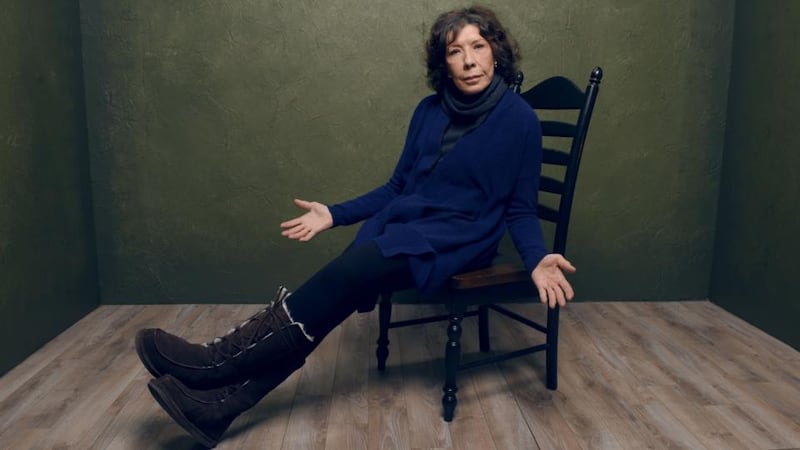Lily Tomlin received her first Oscar nod back in 1976 for her role as a gospel singer in Robert Altman's Nashville. Having grown up watching the Oscars during the 1950s, she turned up resplendent in shoulder pads, elbow-length gloves and white stoles, prompting Mr Blackwell – the originator of the "10 worst-dressed women" list – to remark, "Lily Tomlin: we do not wear tiaras."
Happily, it looks as though Tomlin will be dusting off that tiara. In Grandma the veteran comedian, writer, singer and producer is in stellar form as a foul-mouthed, retired lesbian poet attempting to help her teenage granddaughter with an unplanned pregnancy.
The empathetic and hilarious screenplay was written especially for Tomlin by American Pie creator Paul Weitz. Which has to be simultaneously flattering and daunting, right? "And also you have to worry if the script is any good," Tomlin says with a laugh. "But it was. I was very enamoured with it. We started to talk it through right away."

It’s a fun part, and Tomlin relished the opportunity to “swear and rail against just about everything and everyone”. But the screenplay also touches on weightier issues, such as grief, feminism and abortion, without ever losing its cool – or, indeed, its sense of humour.
Still, judging by the comments sections attached to certain American reviews, at least two of those issues seem to be more contentious than ever.
“My family, who are from Kentucky, are quite religious,” says Tomlin. “They draw the line at abortion too. It’s an issue for them. I think that because there’s been so much progress in other areas, people have gravitated to abortion, and it has become a battleground. But I don’t think anybody is in favour of abortion. They’re in favour of the idea that women should have autonomy over their own bodies. But I don’t think anybody would proselytise for abortion.”
Blue-collar upbringing
Mary Jean Tomlin was born in Detroit, Michigan to southern Baptists who left Kentucky during the Great Depression. It was a blue-collar upbringing.
“We were a working-class family,” she says. “My parents didn’t pay that much attention. They let us go our own way. In our neighbourhood the boy was okay if he didn’t end up in jail and the girl was okay if she didn’t get pregnant. That was the credo by which we lived. They didn’t think anything else could possibly go wrong.”
She studied biology at college but changed her major when she was asked to perform a piece to pad out a revue show.
"I remember the other sketches were so collegiate and sophomoric – like a parody of Gunsmoke – that kind of thing. I had a monologue in which I was a Grosse Point matron. Grosse Pointe was a very rich suburb of Detroit; it still is. And at that time, in 1952, it was covertly segregated and morally corrupt. And it was a huge hit."
That success inspired Tomlin to have a crack at Broadway. She went with $45 – “five bucks from nine friends” – travelling on a prop plane that cost $19 one way.
"I wanted to study mime," she says with a laugh. "But then I discovered that everyone said they wanted to study mime. Because everyone was too hip to admit that they wanted to act. That would have been really narcissistic and uncool. I'd just seen Breakfast at Tiffany's, so I had a cream trench coat from a thrift shop and I used to pile my hair on my head to make an Audrey Hepburn kind of hairdo. You know: scarf over the top of it and sunglasses. And I got a job as an assistant bookkeeper that Monday."
Her stand-up routines quickly migrated from stage to television. By 1969 she was a regular on NBC's sketch-comedy show Rowan & Martin's Laugh-In, where she developed much-loved characters such as Ernestine, the condescending telephone operator ("We don't care, we don't have to . . . we're the phone company"); Edith Ann, an eye-wateringly honest five-year-old; and Susie, a proto-Valley Girl.
"Actually, my first time on television was not successful," says Tomlin. "It was on The Garry Moore Show. He was making a comeback in 1966. Well, he took one look at me and thought I could be his Carol Burnett. So I met the writer and they asked me if I could do anything on television. And I said, 'Sure. I can do a barefoot tap dance'. It was the first thing that popped into my head. Well, you can imagine how that went."
Tomlin recorded successful comedy albums and TV specials throughout the 1970s. In 1977 she featured on the cover of Time magazine as the "new queen of comedy". Two years earlier the same publication had approached her with an offer to put her on the cover if she used the opportunity to "come out". She declined and waited until 2013 to marry Jane Wagner, her long-time collaborator and domestic partner of some 40 years.
Acceptability
Fame has always come second to Tomlin’s integrity. In 1970 she turned down an offer of $500,000 to play Ernestine in an AT&T commercial.
"If there's something in a script that makes me look squint-eyed, then I won't do it," says the 76-year-old. "I used to tease [Jane] Fonda because she took a part that was offered to me. It was for the movie version of Neil Simon's play California Suite. What I didn't like was that there was a passed-out prostitute who was treated like a side of ham. I just thought that was out of sight in terms of acceptability. But Fonda created the workout because she had to appear in a bikini in that film. So I always tell her she owes half of those earnings to me."
Tomlin and Fonda have been firm friends since they appeared together in 9 to 5. They're currently appearing together in the Netflix series Grace and Frankie, a single-camera comedy from the creator of Friends. When the two women realised that their "starring" pay cheques were the same as those of "supporting" male stars Sam Waterston and Martin Sheen, a petition was soon in circulation.
“I feel that there are so many people who are feminists but they don’t know it or accept it,” she says. “There is progress that needs to be made. Not so long ago Jennifer Lawrence wrote a letter about equal pay in her own inimitable style. So there are certain hardcore issues that people are finally waking up to. It’s just a long, long process. Like every damned thing in the world.”
- Grandma opens on December 11th
RACE FOR BEST ACTRESS How the Oscar odds are shaking out
In the race for best actress, you won't get much return on runaway favourite Brie Larson. The star of Irish director Lenny Abrahamson's harrowing Room is getting quoted at between 6/4 and 11/8. Cate Blanchett is a close second favourite – at about 11/4 – for a role that is clearly properly "supporting" when set beside Rooney Mara, who appears in every scene of Todd Haynes's Carol. Saoirse Ronan is in with a shout: the Irish star has just been named best actress for Brooklyn by the New York Film Critics Circle. Shop around: the odds vary between 8/1 and 9/1. But don't rule out Lily Tomlin, who is tremendous in Grandma. At 25/1, she's well worth a flutter.
















